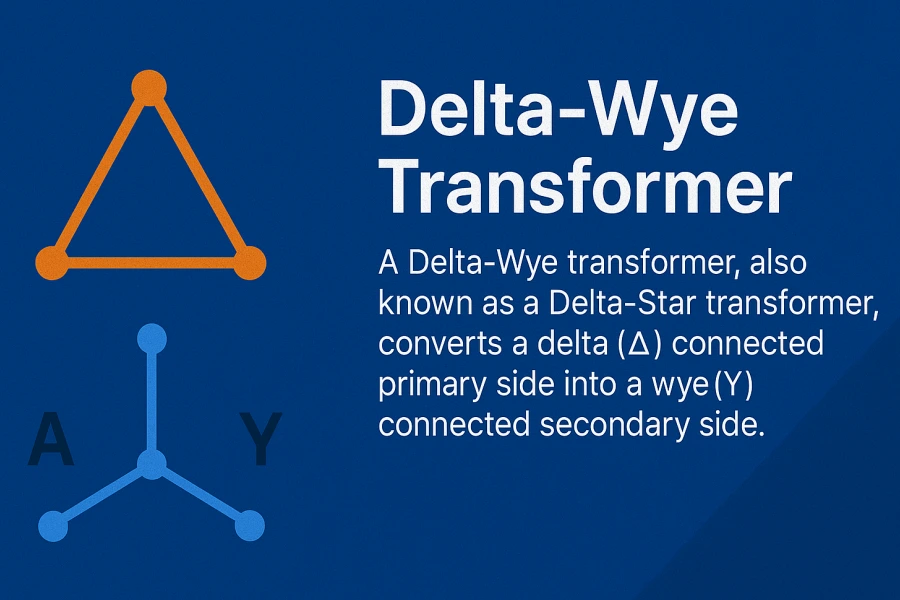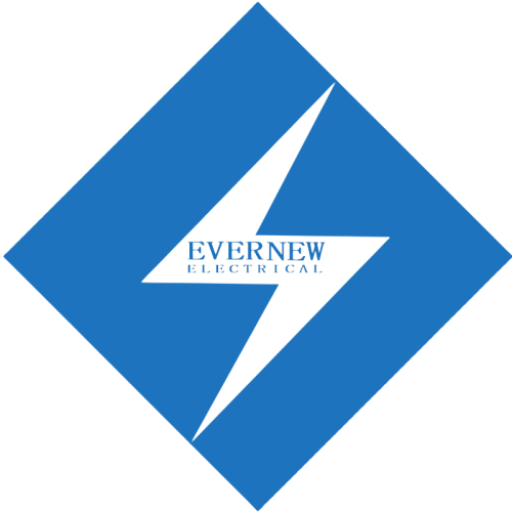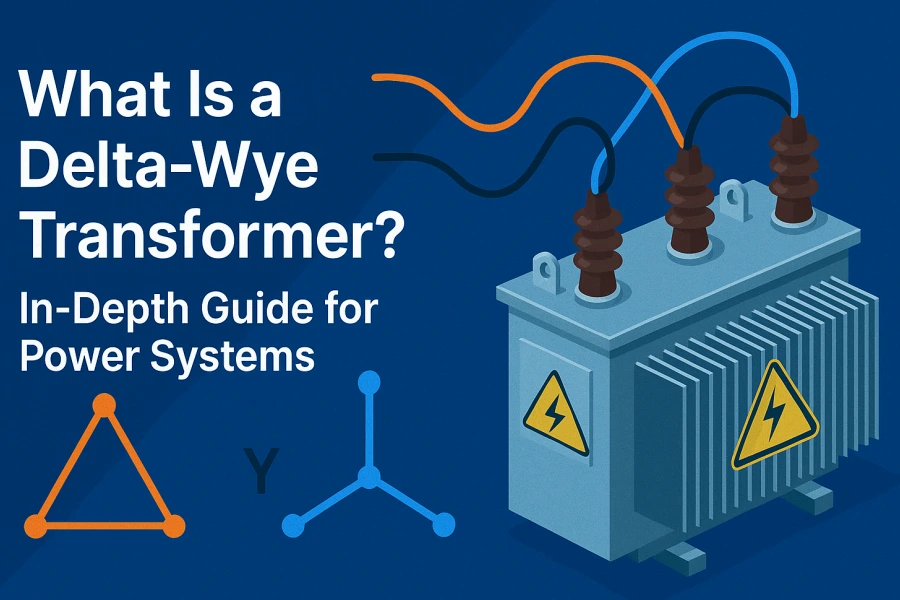Trafo Delta-Wye, sering ditulis sebagai trafo Δ-Y, adalah konfigurasi yang banyak digunakan dalam sistem tenaga tiga fase. Ini memungkinkan transformasi tegangan yang efektif antara tingkat pembangkitan, transmisi, dan distribusi, terutama di jaringan komersial dan industri di seluruh Amerika Utara, Eropa, dan pasar global lainnya. Panduan ini mengeksplorasi prinsip-prinsip operasi, desain struktural, manfaat teknis, kasus penggunaan, dan kriteria pemilihan utama untuk transformator Delta-Wye.
1. Konsep Dasar Transformator Delta-Wye
A Trafo Delta-Wye adalah transformator tiga fase di mana belitan primer dihubungkan dalam konfigurasi delta (Δ), dan belitan sekunder dihubungkan dalam konfigurasi wye (Y atau bintang). Desain ini mendukung transmisi tegangan tinggi dan distribusi tegangan rendah yang efisien, dengan manfaat tambahan berupa titik netral.
Delta (Sisi Primer):
- Ketiga belitan dihubungkan dari ujung ke ujung untuk membentuk loop tertutup (segitiga).
- Umum digunakan pada jaringan transmisi tegangan menengah dan tinggi.
Wye (Sisi Sekunder):
- Salah satu ujung setiap belitan terhubung ke titik netral yang sama.
- Memungkinkan output tegangan line-to-line dan line-to-netral.
- Cocok untuk distribusi daya tegangan rendah.
Pelajari Lebih Lanjut:Sambungan Belitan Transformator Umum dan Aplikasinya
2. Prinsip Kerja Fungsional
Konfigurasi delta primer menerima input tegangan tinggi, dan wye sekunder memberikan tegangan yang diturunkan. Sambungan delta mentoleransi beban yang tidak seimbang dan mengisolasi gangguan arde di sisi primer. Sisi wye memperkenalkan netral, memungkinkan operasi yang diarde dan kompatibilitas dengan beban fase tunggal.
Karakteristik penting adalah pergeseran fasa 30 derajat antara tegangan primer dan sekunder, yang berdampak pada sinkronisasi sistem ketika transformator diparalelkan.
3. Keuntungan Utama dari Delta-Wye Transformers
- Kemampuan Penurunan Tegangan: Secara efisien mengubah tegangan transmisi tinggi (misalnya, 13,8kV, 34,5kV) ke tingkat distribusi standar (misalnya, 400Y/230V atau 208Y/120V).
- Ketersediaan Netral: Wye sekunder memungkinkan koneksi ke beban tiga fase dan satu fase.
- Fleksibilitas Pengardean: Memfasilitasi pengoperasian yang lebih aman dengan mengardekan netral.
- Mitigasi Harmonik: Gulungan delta menyaring harmonisa tiga kali lipat (ke-3, ke-9, dst.).
- Toleransi Beban Tidak Seimbang: Gulungan delta mendukung ketidakseimbangan beban tanpa distorsi tegangan yang signifikan.
- Isolasi Antar Sistem: Secara elektrik memisahkan primer dari sekunder, sehingga meningkatkan keamanan.
4. Aplikasi Umum
- Gardu Induk Utilitas: Trafo step-down di gardu distribusi.
- Bangunan Komersial: Kompleks perkantoran dan pusat perbelanjaan yang membutuhkan 208Y/120V atau 400Y/230V.
- Pabrik Industri: Untuk menggerakkan alat berat dan menyediakan suplai fase tunggal tambahan.
- Energi Terbarukan: Antarmuka antara inverter angin/surya dan jaringan lokal.
- Pusat Data: Pasokan yang stabil dan seimbang dengan akses netral untuk beban TI.
Baca Lebih Lanjut:10 Kesalahan Teratas yang Harus Dihindari Saat Membeli Transformator Daya (dan Cara Memilih yang Tepat)
5. Konfigurasi Tegangan Umum
| Tegangan Primer | Tegangan Sekunder | Gunakan Wilayah |
|---|---|---|
| 13,8 kV | 208Y / 120 V | Amerika Utara |
| 33 kV | 400Y/230 V | Eropa/Asia |
| 11 kV | 380Y / 220 V | Timur Tengah/Amerika Latin |

6. Pertimbangan Teknis untuk Pemilihan
Ketika memilih transformator Delta-Wye, para insinyur harus mengevaluasi:
- Profil Beban: Tentukan beban total, fase, dan jenis (resistif, induktif).
- Peringkat Tegangan Primer/Sekunder: Cocokkan dengan tingkat transmisi dan distribusi lokal.
- Kapasitas (kVA atau MVA): Memastikan margin yang cukup untuk beban yang diharapkan dan yang akan datang.
- Kelas Isolasi: Selaraskan dengan persyaratan termal (mis., Kelas F, H).
- Impedansi dan Kekuatan Hubung Singkat: Untuk koordinasi dengan perangkat pelindung.
- Metode Pendinginan: Terendam oli (ONAN/ONAF) vs tipe kering, tergantung lingkungan.
- Kepatuhan Standar: Memastikan kesesuaian dengan standar IEEE, IEC, ANSI, atau UL.
7. Tantangan dan Solusi
- Dampak Pergeseran Fase: Perbedaan fase 30 derajat harus dikelola dalam sistem multi-transformator.
- Pengardean Netral: Skema pengardean yang tepat sangat penting untuk koordinasi perlindungan.
- Sensitivitas Harmonik: Meskipun delta membantu, filter tambahan mungkin diperlukan pada instalasi yang sensitif.
8. Kesimpulan
Trafo Delta-Wye adalah komponen penting dalam sistem tenaga modern, menyediakan transformasi serbaguna dan andal antara transmisi tegangan tinggi dan distribusi tegangan rendah. Dengan desain yang seimbang, dukungan pengardean, dan penyaringan harmonik, transformator ini ideal untuk berbagai aplikasi, mulai dari gardu induk hingga infrastruktur komersial.
Memilih trafo Delta-Wye yang tepat melibatkan evaluasi yang cermat terhadap karakteristik beban, kelas tegangan, tingkat isolasi, dan lingkungan pemasangan. Dengan pemilihan dan pemeliharaan yang tepat, mereka menawarkan stabilitas dan efisiensi jangka panjang dalam jaringan listrik yang menuntut.

